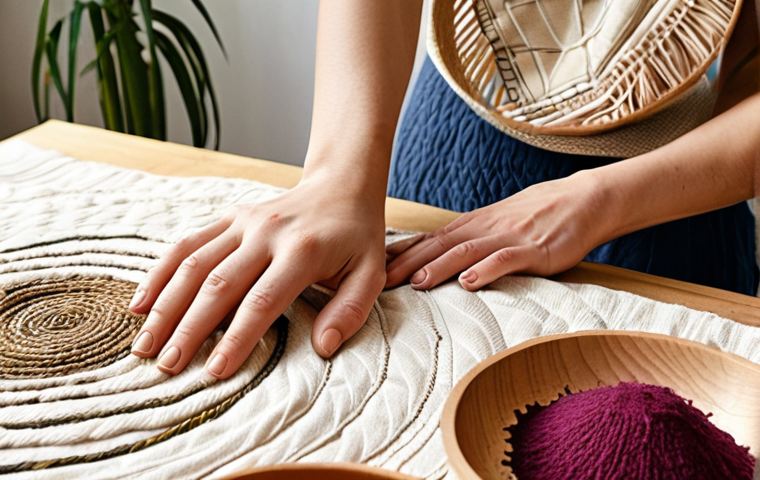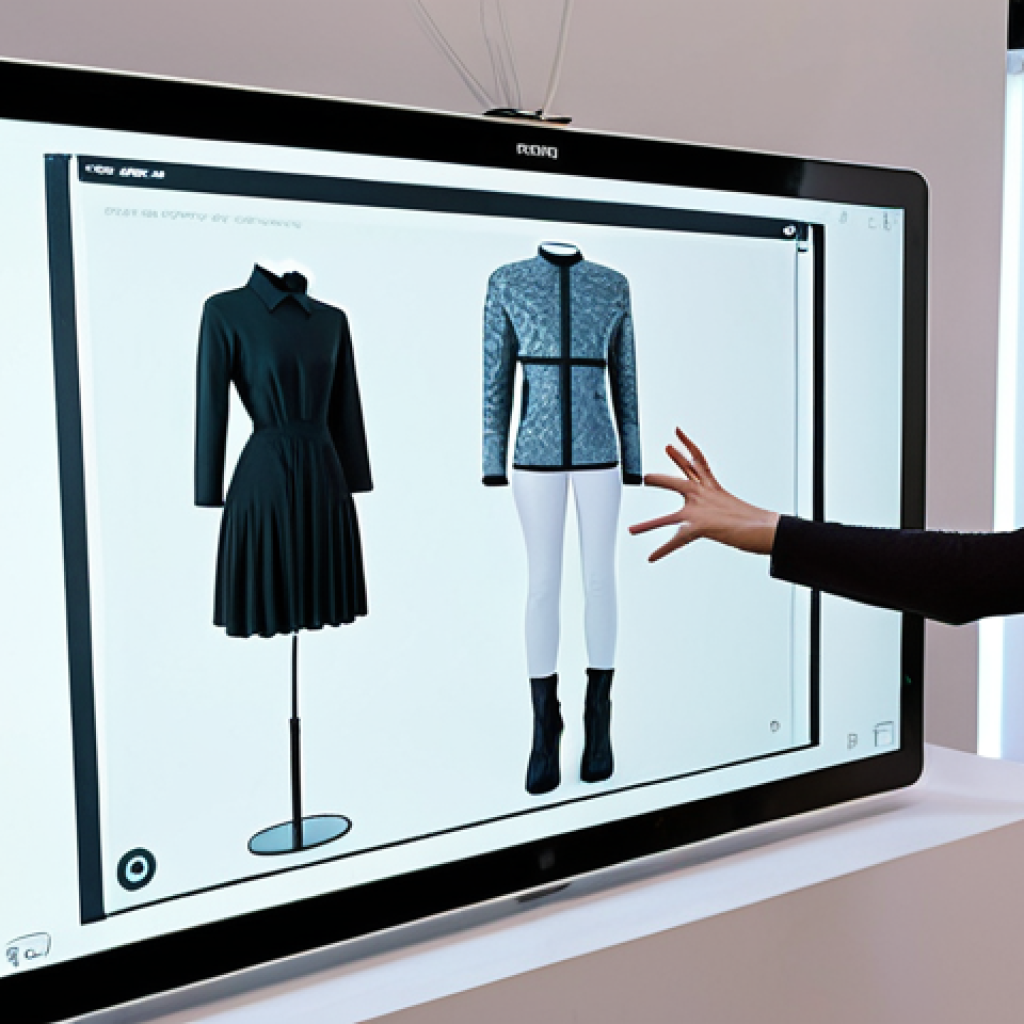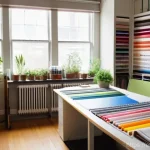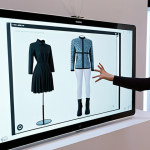That moment when you’re about to present your fashion design portfolio – it’s a whirlwind of excitement, nerves, and a dash of sheer terror, isn’t it?
I remember feeling that knot in my stomach, knowing this wasn’t just about showing off clothes, but about baring a piece of my soul and vision to the world.
It’s more than just meticulously organized sketches and fabric swatches; it’s your brand story, your creative voice, and frankly, your future, all rolled into one compelling narrative.
In today’s fiercely competitive and rapidly evolving fashion landscape, simply having great designs isn’t enough. The industry is constantly shifting, embracing digital innovation, hyper-personalization, and demanding transparency and sustainability like never before.
From immersive augmented reality experiences for showcasing collections to leveraging AI tools to predict trends and streamline design, the presentation game has changed dramatically.
Your portfolio isn’t just a static document; it’s a dynamic, living testament to your ability to adapt, innovate, and tell a compelling story that resonates deeply.
You need to capture attention, hold it, and leave a lasting impression that shouts, “I’m not just a designer; I’m a visionary for tomorrow’s fashion world.”Let’s dive deeper below.
Beyond the Visuals: Crafting Your Narrative Identity

When I first started out, I thought a portfolio was just a collection of pretty pictures and sketches. Boy, was I wrong! It’s so much more than that; it’s a living, breathing narrative of who you are as a designer, what you stand for, and the unique problems you solve with your creativity.
Think about it: a hiring manager or potential client isn’t just looking at a dress; they’re trying to understand your design philosophy, your process, and how you think.
I remember one pivotal moment early in my career, during a portfolio review with a seasoned industry veteran. She didn’t dwell on the perfect seam or the intricate embroidery as much as she did on the story behind each piece – what inspired it, the challenges I faced, and what I learned.
That conversation was a massive lightbulb moment for me. It taught me that my portfolio needed to articulate not just *what* I designed, but *why* and *how* I designed it, showcasing my journey, my struggles, and ultimately, my growth.
It’s about demonstrating your unique voice and perspective in a crowded marketplace, showing that you’re not just following trends but shaping them. This narrative identity is what truly sets you apart and makes your work memorable, compelling the viewer to spend more time with your pieces, understanding the depth behind each stitch and silhouette.
1. Defining Your Core Design Philosophy
Your design philosophy is the guiding star of your creative universe. It’s the set of principles and beliefs that inform every decision you make, from fabric choice to silhouette construction.
For me, it evolved from a youthful obsession with avant-garde forms to a deep commitment to sustainable, functional elegance. I’ve learned that clearly articulating this philosophy within your portfolio is crucial because it gives context to your work and shows consistency in your vision.
Potential employers aren’t just looking for someone who can draw; they’re looking for a mind that aligns with their brand’s values, someone who can contribute meaningfully to their long-term creative direction.
This isn’t a static statement you write once and forget; it’s a dynamic declaration that evolves with your experiences and learning. I encourage you to spend time reflecting on what truly drives your design decisions, the impact you want to make, and how your personal values intertwine with your creative output.
Is it innovation? Sustainability? Inclusivity?
Comfort? The more clearly you define this, the more coherent and impactful your entire portfolio will become, drawing in the right kind of attention from those who resonate with your mission.
2. Weaving Your Personal Journey into Project Stories
Every single project, every sketch, every garment in your portfolio has a story behind it. Don’t just show the finished product; take your audience on the journey of its creation.
What was the initial spark of an idea? What research did you conduct? What challenges did you encounter, and more importantly, how did you overcome them?
I recall a collection where I experimented with natural dyes, and half my samples turned out completely wrong. Instead of hiding that, I included photos of the failed attempts and explained the problem-solving process that led me to the successful outcome.
It showed resilience, adaptability, and a deep understanding of my materials – qualities that are highly valued in the industry. This level of transparency and vulnerability makes your portfolio relatable and human, demonstrating not just your technical skills but also your problem-solving abilities and tenacity.
It provides a deeper insight into your thought process and resilience, making your portfolio a more engaging and memorable experience for the viewer.
Mastering the Digital Canvas: Your Online Presence is Paramount
In today’s lightning-fast fashion world, if your portfolio isn’t digitally optimized and easily accessible, you’re essentially invisible. This isn’t just about having a website; it’s about curating a powerful, intuitive, and visually stunning online presence that screams “professional” and “innovative.” I’ve seen countless brilliant designers whose work gets lost because their digital presentation is clunky, slow, or just plain uninspired.
My own journey into the digital realm was a steep learning curve. I initially just uploaded low-res JPEGs to a free site, thinking “good enough.” It wasn’t until I invested time (and a little money) into a professional platform with high-quality images, interactive elements, and a seamless user experience that I truly started getting noticed by top-tier agencies and brands.
Your digital portfolio is often the first, and sometimes only, impression you’ll make. It needs to be polished, professional, and reflective of your aesthetic and brand identity.
This isn’t just about aesthetics; it’s about user experience, ensuring that anyone, anywhere, can quickly grasp your vision without friction, increasing their time spent engaging with your content.
1. Curating an Immersive Digital Experience
An online portfolio should be an experience, not just a gallery. Think about how you can use digital tools to your advantage. Can you include 360-degree views of garments?
Short, high-quality videos of your pieces in motion or showing your design process? Interactive mood boards? When I recently updated my site, I added a behind-the-scenes video of my pattern-making process for a complex couture gown.
The engagement skyrocketed. People love seeing the craftsmanship and the story unfold. This isn’t about throwing everything online; it’s about strategically selecting elements that enhance the viewer’s understanding and appreciation of your work.
Consider using features like zoom functions for fabric details, embedded sound clips explaining design choices, or even virtual try-on experiences if you have the tech.
The goal is to make the viewer feel like they are right there with you, exploring the textures, cuts, and intentions behind each design.
2. Leveraging Social Media and Professional Platforms
Your digital portfolio isn’t an island; it’s part of a broader ecosystem. Platforms like Instagram, Pinterest, and LinkedIn are indispensable for extending your reach and building a professional network.
But it’s not just about posting pretty pictures. It’s about strategic content creation. Share your process, your inspirations, snippets of your sketchbook, and engaging behind-the-scenes glimpses.
I’ve found that consistently posting high-quality content, interacting with my followers, and participating in relevant conversations on these platforms has led to unexpected opportunities and collaborations.
LinkedIn, specifically, is invaluable for connecting with industry professionals and showcasing your expertise beyond just visuals. Remember, these platforms are about community and conversation; they offer a chance to demonstrate your personality, your passion, and your ongoing engagement with the fashion world.
The Art of Curation: Quality Over Quantity, Always
It’s a common pitfall: the desire to show *everything* you’ve ever designed. Trust me, I’ve been there, cramming every single project from my college days into my portfolio.
What I quickly learned, the hard way, was that this approach dilutes your strongest work and overwhelms the viewer. The true mastery of a portfolio lies in the art of rigorous curation – selecting only your absolute best, most representative pieces that speak directly to the kind of work you want to do and the designer you aspire to be.
It’s like preparing a Michelin-star meal; you wouldn’t serve every ingredient in your pantry, but rather a perfectly composed dish that highlights the finest flavors.
The aim is to leave a lasting impression of excellence and clear vision, not a chaotic jumble of ideas. This selective process not only showcases your critical eye but also demonstrates your understanding of current industry standards and your ability to focus on what truly matters.
1. Identifying Your Signature Style and Niche
Before you even start selecting pieces, you need to be crystal clear about your signature style and the niche you want to carve out for yourself. Are you a minimalist, a maximalist, a sustainable pioneer, or a tech-savvy innovator?
Your portfolio should reflect this identity cohesively. For example, if you aspire to work in haute couture, you wouldn’t fill your portfolio with fast-fashion sketches.
I spent years refining my own niche, moving from general fashion to a specific focus on adaptive design with a sustainable twist. This clarity allowed me to ruthlessly edit my portfolio, removing anything that didn’t align with this core focus.
It’s about presenting a focused narrative that tells a clear story about your unique contribution to the fashion world. Think about the specific segment of the industry that excites you most and tailor your selections to resonate deeply with that audience.
2. Strategic Selection and Presentation of Projects
Once your niche is clear, the selection process becomes much easier. Choose projects that showcase a diverse range of skills within your niche – from initial concept development and research to technical flats, fabric swatches, and final garment construction.
Each project should tell a complete story, but be concise. For each piece, include high-quality photography, a brief explanation of the concept, the inspiration, materials used, and any unique challenges or solutions.
Remember, it’s not just about the clothes, but the narrative and the craftsmanship. I always advise presenting pieces in a logical flow, perhaps by collection or by thematic idea, ensuring that one design naturally leads to the next, creating a cohesive visual journey for the viewer.
| Portfolio Element | Traditional Portfolio (Physical) | Modern Portfolio (Digital) |
|---|---|---|
| Core Format | Large print boards, bound books, fabric swatches | Interactive websites, PDFs, video reels |
| Presentation Scope | Limited to physical space; static images | Global reach; dynamic, multimedia content |
| Interactivity | Low; viewer handles physical objects | High; zoom, 360 views, embedded videos, click-throughs |
| Feedback & Iteration | Slower; in-person reviews, physical notes | Faster; online comments, analytics, quick updates |
| Accessibility | Requires physical presence or shipping | 24/7 access from anywhere with internet |
| Sustainability Footprint | Higher material consumption (paper, fabric samples) | Lower; reduced physical waste, digital-first approach |
| Cost (General) | Printing, materials, travel for presentations | Domain, hosting, software subscriptions |
Sustainability and Ethics: Weaving Values into Your Vision
The fashion industry is undergoing a seismic shift, with sustainability and ethical practices moving from niche concerns to fundamental expectations. A modern fashion design portfolio isn’t complete without demonstrating your awareness of and commitment to these critical issues.
I remember a few years ago, these topics were just starting to gain traction, and I was hesitant to include them extensively in my portfolio, worried it might pigeonhole my work.
But as I saw the industry evolve, and especially as I observed consumer demand for transparency and eco-conscious brands skyrocket, I realized it wasn’t just a trend – it was the future.
Brands are actively seeking designers who can integrate sustainable practices from concept to production, understanding supply chains, circular design principles, and ethical labor.
Showing your commitment here isn’t just about being socially responsible; it’s about being strategically relevant and forward-thinking in a market that increasingly values purpose alongside profit.
It demonstrates that your creative vision extends beyond aesthetics, encompassing a holistic understanding of the industry’s impact and your potential role in shaping a more responsible future.
1. Showcasing Eco-Conscious Design Choices
How do you integrate sustainability into your actual designs? Think about material sourcing, zero-waste pattern cutting, upcycling, or innovative textile development.
For one of my recent collections, I specifically focused on using deadstock fabrics and developing modular garments that could be disassembled and recycled.
I included a detailed section in my portfolio explaining this process, showing prototypes and highlighting the environmental impact reduction. This isn’t about grand gestures but about thoughtful, intentional choices in your design process.
Even small details, like your choice of dye or your approach to sample creation, can speak volumes about your commitment. Be specific and provide evidence – not just a statement that you are “sustainable,” but concrete examples of *how* your designs embody these principles.
This could include:
- Research into biodegradable or recycled materials.
- Documentation of your zero-waste pattern cutting techniques.
- Case studies on extending garment lifecycle through versatile design.
- Exploration of natural dyeing or low-impact finishing processes.
2. Articulating Ethical Production and Social Impact
Beyond environmental considerations, the ethical dimension of fashion – fair labor, transparency in supply chains, and community engagement – is equally vital.
If you’ve had experience working with artisans, promoting fair trade practices, or designing for social impact, this is your moment to shine. My initial foray into this was a small capsule collection made in collaboration with a local women’s cooperative, ensuring fair wages and empowering their traditional craft.
Documenting this project in my portfolio, complete with behind-the-scenes photos and testimonials, conveyed a powerful message about my values and my commitment to ethical practices.
It showed that my designs were not just beautiful, but also responsible, aligning with the growing consumer demand for brands that care. This demonstrates a holistic understanding of the fashion ecosystem, from concept to the hands that bring the garments to life.
Nailing the Presentation: From Pitch to Lasting Impression
You can have the most breathtaking portfolio in the world, but if you can’t present it effectively, all that hard work might go unnoticed. This is where the performance aspect comes in – the confidence, the clarity, and the connection you build with your audience.
I used to dread presentations, my voice would quiver, and I’d rush through my explanations. It took countless practice sessions, and even some public speaking courses, to transform that nervous energy into genuine passion.
Remember, a portfolio review isn’t just about showing your work; it’s about selling your vision, your personality, and your potential. It’s an opportunity to create a memorable experience that resonates long after you’ve left the room.
This extends beyond the verbal pitch; it encompasses everything from your professional demeanor to your ability to answer challenging questions with grace and insight.
1. The Art of the Concise and Compelling Pitch
Imagine you have just 60 seconds to grab someone’s attention. What would you say? Your elevator pitch for your portfolio should be concise, compelling, and memorable.
It needs to encapsulate your unique selling proposition, your design philosophy, and what makes your work stand out. Practice this pitch until it flows naturally.
I always recommend tailoring your pitch to the specific person or company you’re speaking with – research their brand, their recent collections, and their values, then subtly weave these insights into your narrative.
Show them you’ve done your homework and that you’re not just showing up, but showing up prepared and genuinely interested. This demonstrates not just your creative skill, but also your business acumen and strategic thinking.
2. Engaging Your Audience and Handling Q&A
A portfolio review is a dialogue, not a monologue. Encourage questions, be ready to elaborate, and engage actively with your audience. When asked a tough question about a design choice or a challenge, don’t shy away.
Be honest, explain your reasoning, and highlight what you learned from the experience. I once had an interviewer really dig into why I chose a particular, difficult fabric.
Instead of getting flustered, I calmly explained the material’s properties, the challenges it presented, and how I innovated to overcome them, ultimately highlighting my problem-solving skills.
Your ability to articulate your thought process, defend your decisions, and reflect on your experiences demonstrates a maturity and professionalism that is highly valued.
Remember, confidence comes from preparation, but genuine engagement comes from passion.
Leveraging Networks: The Power of Connection in Fashion
In the fashion industry, it’s often said, “it’s not what you know, but who you know.” While talent and a strong portfolio are non-negotiable, building and nurturing a robust professional network is equally crucial for opening doors and creating opportunities.
My early career was a testament to this; my first significant freelance gig didn’t come from a job application, but from a recommendation by a former professor who knew my work and my work ethic.
Networking isn’t just about collecting business cards; it’s about forging genuine relationships, offering value, and staying connected with people who share your passion and can potentially advocate for your talent.
It’s about being visible in the right circles and understanding that every interaction, from a casual coffee meeting to a formal industry event, is an opportunity to expand your professional footprint.
1. Strategic Networking and Mentorship
Don’t just network aimlessly; be strategic. Identify key individuals or companies you admire and seek opportunities to connect with them. Attend industry events, virtual workshops, and portfolio reviews.
Be prepared to introduce yourself concisely and articulate your passion. But more importantly, listen, learn, and offer value. Mentorship has been an absolute game-changer for me.
Finding someone who has walked the path you aspire to follow can provide invaluable guidance, open doors, and offer honest feedback on your portfolio and career trajectory.
I still regularly connect with mentors who have helped me navigate challenging decisions and celebrated my successes, illustrating the long-term benefit of these relationships.
These connections often lead to unexpected collaborations or opportunities you wouldn’t have found through traditional channels.
2. The Importance of Follow-Up and Relationship Nurturing
Connecting is just the first step; nurturing the relationship is where the real magic happens. A polite, personalized follow-up email after an event or meeting is crucial.
Don’t just ask for something; offer something in return, whether it’s sharing an interesting article, inviting them to a relevant event, or simply checking in.
I keep a detailed record of my network, noting key details about our conversations so my follow-ups are always personal and meaningful. Remember, these are professional relationships, built on mutual respect and genuine interest.
It’s about being a valuable part of their network, just as they are a valuable part of yours. Consistent, respectful engagement over time builds trust and keeps you top-of-mind when opportunities arise.
Anticipating Trends: Future-Proofing Your Design Vision
The fashion industry is a perpetual motion machine, constantly evolving with new technologies, shifting consumer behaviors, and emerging global challenges.
To truly stand out, your portfolio can’t just reflect what’s current; it needs to hint at what’s next. This means demonstrating an intuitive understanding of emerging trends, not just in aesthetics, but in materials, production methods, and even consumption patterns.
I remember when sustainability was still a niche concept; those who incorporated it early into their work became thought leaders. The same applies now to areas like AI in design, hyper-personalization, digital fashion, and even bio-fabrication.
Your portfolio should convey that you’re not just a designer reacting to the present, but a visionary shaping the future. It’s about showcasing your ability to think critically about the trajectory of the industry and how your unique design perspective can contribute to its evolution.
1. Researching and Integrating Future-Forward Concepts
How do you integrate future trends into a portfolio that’s meant to showcase your past work? It’s about framing your projects through a forward-looking lens.
For each collection, include a section on your trend research – what inspired you, what societal shifts influenced your choices, and how you envision your designs fitting into the future landscape.
I often include mood boards that aren’t just about colors and silhouettes, but also about technological advancements or cultural movements. For example, when working on a project about adaptable clothing, I researched smart textiles and integrated conceptual ideas about their application, even if I couldn’t physically produce them yet.
This shows your intellectual curiosity and your capacity for innovation. It’s about demonstrating your ability to anticipate where the industry is heading and position yourself at the forefront of that movement.
2. Showcasing Adaptability and Continuous Learning
The fashion landscape changes so rapidly that the ability to adapt and continuously learn is arguably as important as your initial design talent. Your portfolio should subtly convey this resilience and hunger for knowledge.
Have you taken courses in new design software? Explored 3D rendering? Attended workshops on circular design principles?
Include examples of how you’ve integrated new skills or knowledge into your work, even if it’s a small experimental project. This demonstrates that you’re not static; you’re growing, evolving, and staying relevant.
I make a point of including a dedicated section on my ongoing professional development and any experimental projects that push the boundaries of my comfort zone, showing that I’m always striving to learn and grow, even if the outcomes aren’t always ‘perfect’ or commercially ready.
It shows a dynamic, evolving mind, ready to tackle the challenges of tomorrow’s fashion world.
Wrapping It Up
Building a powerful fashion design portfolio isn’t a one-time task; it’s an ongoing journey of self-discovery, continuous learning, and strategic presentation.
It’s about more than just showcasing beautiful designs; it’s about articulating your unique vision, demonstrating your process, and proving your readiness to shape the future of fashion.
I truly hope that sharing my own insights and experiences has provided you with a clear roadmap to elevate your portfolio from a mere collection of works to a compelling narrative that truly reflects the designer you are and aspire to be.
Remember, your portfolio is your voice in a crowded industry – make sure it sings! Keep refining, keep networking, and never stop telling your incredible design story.
Useful Information
1. Invest in Professional Photography: Blurry, poorly lit photos are a killer. Whether it’s for physical pieces or digital mockups, high-quality visuals are non-negotiable. Consider hiring a professional or investing in good lighting and a decent camera if you’re serious about showcasing your work at its best.
2. Get Feedback Early and Often: Don’t work in a vacuum. Share your portfolio with mentors, professors, or trusted industry professionals. Their fresh perspectives can reveal blind spots and help you refine your narrative and presentation before it really counts.
3. Tailor Your Portfolio: One size does not fit all. Always customize your portfolio, or at least highlight specific projects, for each job application or client pitch. Show them you understand *their* needs and how your unique skills align.
4. Consider a Personal Brand Statement: Beyond your design philosophy, a concise personal brand statement (1-2 sentences) can instantly communicate your core value proposition. It’s your unique selling point, woven into the fabric of who you are as a designer.
5. Set Up Google Analytics for Your Digital Portfolio: If you have an online portfolio, implement Google Analytics. Understanding who visits your site, how long they stay, and which projects they click on can provide invaluable insights for future optimization and help you gauge engagement.
Key Takeaways
Your fashion design portfolio is your most powerful tool to communicate your narrative identity, showcasing not just *what* you design, but *why* and *how*.
Mastering your digital presence is paramount for global reach and immersive experiences. Curate rigorously, prioritizing quality over quantity to highlight your signature style and niche.
Weave sustainability and ethical practices into your vision, demonstrating a forward-thinking and responsible approach. Nail your presentation with a concise pitch and engaging Q&A, proving your professionalism and ability to articulate your vision.
Finally, leverage strategic networking and anticipate future trends to continuously grow and future-proof your design career in the ever-evolving fashion landscape.
Frequently Asked Questions (FAQ) 📖
Q: In this rapidly evolving digital fashion landscape, how do I truly make my portfolio dynamic and engaging, rather than just a static collection of images?
A: Oh, this is the million-dollar question, isn’t it? I remember the days when a beautiful print portfolio felt like the pinnacle. Now?
It’s a whole different ballgame. To make your portfolio dynamic, you really have to think beyond just JPEGs and PDFs. My take?
It’s about creating an experience. Think about using subtle animations for your mood boards, or embedding short, high-quality video lookbooks that literally bring your designs to life.
I’ve seen some incredible examples where designers use 3D renders or even basic AR overlays – imagine someone pointing their phone at your portfolio and seeing a dress spin in 3D!
It’s not just about showing the final garment; it’s about illustrating your process digitally. Maybe a time-lapse of a sketch becoming a toile, or a mini-documentary about your fabric sourcing journey.
The goal is to make a viewer lean in, curious about what’s next, rather than just flicking through. It leaves a tangible, memorable imprint, shouting, “This designer understands tomorrow!”
Q: Beyond showcasing my designs, how do I authentically convey my unique “brand story” and “creative voice” through my portfolio?
A: This, my friend, is where the magic happens and where so many designers miss a beat. Your portfolio isn’t just a catalogue; it’s your autobiography in fabric and form.
Forget the polished, impersonal presentations. My experience has taught me that authenticity is your superpower. Start with a compelling narrative introduction – not just “I design clothes,” but “My work explores the intersection of brutalist architecture and fluid drapery, inspired by the resilience of urban landscapes.” Use your mood boards to tell a story, not just a theme.
Show images that evoke the feeling you want your brand to transmit – is it edgy, serene, rebellious, luxurious? Don’t shy away from sharing your why. What drives you?
What problem are you solving? I even encourage adding a short, personal video where you speak about your design philosophy. It’s like inviting them into your mind.
When I did that, the feedback I got was less about the clothes and more about “I felt like I really knew you.” That’s the connection you’re aiming for.
Q: Given the industry’s increasing demand for sustainability and transparency, how can I effectively integrate these values into my portfolio without it feeling forced or like a mere checklist?
A: Ah, the sustainability question! It’s not just a trend; it’s a fundamental shift, and if it feels like a checklist, you’re doing it wrong. For me, it has to be ingrained in your design philosophy, a non-negotiable.
Don’t just slap a “sustainable” label on it. Show, don’t just tell. For instance, if you’re using repurposed fabrics, include a small section detailing where those fabrics came from, the process of transformation, and the story behind their “second life.” If your brand focuses on ethical production, perhaps showcase a photo of the artisans you work with, or a diagram illustrating your local supply chain.
It’s about genuine storytelling. I recall working on a collection where we used zero-waste pattern cutting; I included the actual pattern diagrams, highlighting how every scrap was utilized.
It wasn’t about preaching; it was about demonstrating a solution. It felt honest, rooted in a true passion for responsible design, and believe me, that resonates far more deeply than any generic claim ever could.
📚 References
Wikipedia Encyclopedia
구글 검색 결과
구글 검색 결과
구글 검색 결과
구글 검색 결과
구글 검색 결과






